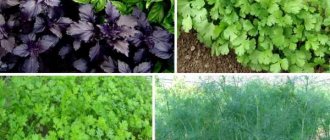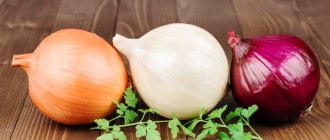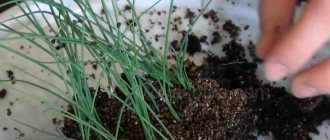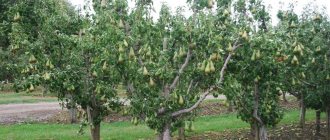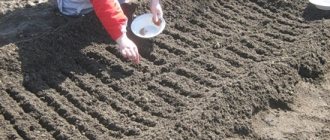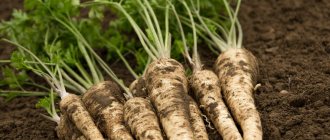Parsley is a spicy representative of greens, revered in any family. It is not surprising that many gardeners are interested in growing this plant. The frost resistance of parsley allows it to be planted almost all year round, and planting before winter has a number of advantages. However, in order to get a bountiful harvest, you need to know the subtleties and nuances of cultivation.
How to grow parsley from seeds on a windowsill at home
So that parsley will delight you with its fresh greens during the long winter, it is grown on the windowsill in the apartment. To do this, prepare containers with fertile soil, prepare it in advance from your garden or buy it in a store.
To make the seeds germinate faster, pre-soak them in warm water or a weak solution of manganese for several hours, then dry until free-flowing. Plant the seeds in prepared containers at a distance of 2-3 cm from each other to a depth of no more than 1 cm. Water the plantings and place the container on a warm windowsill.
The first shoots will appear in about 15-20 days, so be patient. And to speed up the emergence of seedlings, cover the containers with film. As soon as the seedlings hatch, remove the film.
Place the plantings on the warmest and well-lit windowsill, periodically water the soil, preventing the soil from drying out. Parsley leaves are cut off when the plant reaches a height of 10 cm or more.
Do you use expired food for cooking at home?
Yes, the main thing is to process it if it is meat or expired kefir for pancakes.
28.05%
No, it is very dangerous and not useful.
37.12%
If the products have fungus or mold, then we throw them away; if they are a couple of days past their expiration date, we use them for food, even without heat or other treatment.
34.83%
Voted: 959
How to plant parsley so that it sprouts quickly
Parsley is a slow-growing crop, so it does not sprout for a long time. The fact is that it is from the umbrella family and these plants, as well as carrots, celery, parsnips, have a sufficient amount of essential oils on the seed shell, which inhibit germination.
To speed up seed germination, you need to wash off these essential oils. For this purpose, the seeds are placed in a gauze bag and washed under moderately hot (very warm) water for 20-30 minutes. You can do this under the tap or dip the bag of seeds in a container of warm water.
After this, the seeds are scattered on paper and dried to a free-flowing state, then sown. This pre-sowing treatment promotes the emergence of seedlings several days earlier.
To speed up seed germination, you can cover the plantings with film after sowing and watering, creating a kind of greenhouse. But if you are afraid that the seeds will burn in hot weather, cover them with spunbond.
Common leaf parsley - when to sow in open ground in spring
The most popular leaf varieties are:
- Italian giant,
- Appetizing,
- Festivalnaya,
- Green crystal,
- Delicate aroma
- Morning freshness
- Bogatyr, etc.
Leaf parsley grows very large leaves and many people confuse it with parsnips. The root of this variety is more like a lobe. The leaf crop grows within one season, but quickly develops a large leaf. But if you leave the plant over winter without digging it up, then the next season the plant will produce a flower stalk, and later you can get your seeds. The seeds may fall to the ground on their own; in the future, your greens may self-sow.
Sowing of crops for greens is carried out around the end of April - beginning of May, depending on the region and weather conditions. It is best to sow the seeds in warm soil, then they will germinate faster. Sow parsley for greens in prepared, well-seasoned areas with slight partial shade. Seeds are sown in furrows to a depth of 1-1.5 cm, then covered with fertile soil from the garden bed. After sowing, plantings are well watered. The first shoots appear after 2-2.5 weeks.
Caring for plantings involves loosening the plantings - 2-3 times per season, and regular watering if the weather is dry. Fertilizing is carried out 1-2 times per season with herbal infusion or complex mineral fertilizers, preferably with a predominance of nitrogen, so that the vegetative mass increases.
As the greenery grows, the stems are cut off with scissors and eaten. The plant then grows new branches of greenery again.
Varieties of curly parsley
Curly parsley is a variety of leaf parsley. It differs from the ordinary one in that the edges of its leaves are wavy and corrugated. Many gardeners, judging by the reviews, believe that this is not the best choice. Explaining this by the fact that its leaves are coarser. But these varieties have the advantage that in the finished dish the leaves hold their shape longer than ordinary leaves.
Popular curly varieties:
- Petra,
- Vologda lace,
- Mooskrause 2,
- Curly, etc.
Suitable varieties of parsley
Not all varieties can be planted before winter. The most suitable are:
- Eagle . It has a lush leaf rosette and is easy to care for.
- Common leaf . Tolerates frost well.
- Esmeralda . It has curly greenery and germinates well.
- Italian giant . Quickly increases the green part.
Popular varieties - choose tasty and aromatic ones
To choose the best varieties, you should decide for what purpose the cultivation is being carried out. There are two main types of plants:
- leafy;
- root
The leaf has a good taste and aroma. It is grown for its lush greenery. It can be curly and ordinary. After cutting, the grass quickly grows back. The branched roots of parsley are inedible. The table shows the most popular varieties:
| Name | Ripening time (days) | Socket characteristics |
| Aster | 65 | Large, highly corrugated dense leaves |
| Common leaf | 70 | Large number of heavily dissected dark green leaves |
| Breeze | 80 | Delicate greens up to 75 cm in height |
| Bogatyr | 60 | Large and juicy leaves, persistent, pronounced aroma |
The root fruit has a prized yellow-white color and is used in pickles, vegetable soups, and folk medicine. It has the shape of a spindle or cone. The leaves of the plant are tough and not very fragrant, but are also used in cooking. The following varieties are distinguished:
| Name | Ripening time (days) | Root size (cm) | Number of leaves per rosette |
| Sugar | 95-100 | up to 30 | 20-40 |
| Harvest | 130 | from 20 | 11-20 |
| Bordovikskaya | 135 | about 35 | 28-30 |
| Berlin | 150-180 | up to 20 | up to 40 |
Selecting a good type of grass is problematic. Some attract with their aroma, others with their beautiful leaf shape, and others with a set of vitamins.
Preparing seeds for planting in open ground
An important factor in obtaining a decent harvest of early spring greens is the correct preparation of seeds for sowing. Many gardeners fail simply because they simply throw planting material into the ground without subjecting it to any preliminary preparation. Experienced gardeners also remember well that pre-winter sowing requires a fairly large number of seeds, since the danger of falling out is greater.
Main stages of preparatory work:
- sorting;
- soaking and disinfection;
- vernalization or pelleting.
Each stage is equally important for success.
At the sorting stage, seeds are distributed based on their size and general appearance, and the presence of damage. Too little planting material may be too weak. At the same time, damaged seeds will rot and will not sprout. Autumn sowing requires special attention to the health of the material.
Soaking, combined with disinfection, is carried out both to activate the swelling process and to increase the plant’s immunity. To prevent parsley from getting sick immediately after germination, it is soaked in a solution of potassium permanganate or boric acid. Copper sulfate is also used.
A modern method of achieving the same goal is sparging. This is the name of the process in which seeds are placed in warm water (temperature 20 degrees Celsius) and oxygen is pumped through a compressor.
Vernalization and pelleting are used to ensure uniform sowing and increase plant vigor. With the first method, the seeds are kept on ice until it evaporates in a wooden box, and with the second, they are covered with a mixture of fertilizers, humus and peat. It is important that each seed appears separately in such a substance.
Parsley - features of cultivation and care in open ground
Parsley is a cold-resistant, shade-tolerant plant. It grows well in all types of soil. Of course, it feels great on well-fertilized and loose soils and loams. But it can also be grown on sandy soils with proper care. The culture loves moisture and partial shade. It can even be grown under fruit trees.
The crop grows poorly after cumin, carrots, and dill. It is better to plant the plant in these areas where they grew no earlier than after 3-4 years. The best predecessors for it are cucumbers, tomatoes, and onions.
Before sowing the seeds, the beds are dug up and organic or mineral fertilizers are applied. Shallow grooves 1-1.5 cm deep are made in the garden bed, where the seeds are then sown. The top of the crops is mulched with fertile soil or humus. The plantings do not require special care; no fertilizing is required on fertile soil. During the season, loosen the soil 3-4 times. On sandy soil, you can feed it 1-2 times per planting season. Fertilizing is carried out with complex mineral fertilizers, or liquid organic ones, when the plant already has 2-3 true leaves.
In order for the leaves to grow large and juicy, the greens need to be watered periodically in the absence of rain. And in order for the soil to retain moisture longer, it is best to mulch the plantings with herbal compost (cut grass). Then moisture will be retained and weeds will not grow. And the compost will gradually rot and feed the plant.
Place the plantings on the warmest and well-lit windowsill, periodically water the soil, preventing the soil from drying out. Parsley leaves are cut off when the plant reaches a height of 10 cm or more.
Pests and diseases of parsley
Parsley diseases
Like other crops, parsley can suffer from various diseases. Parsley is most often affected by:
- Cucumbers: varieties for greenhouses
Powdery mildew is a fungal disease, the symptoms of which look like a loose, almost white coating on the above-ground parts of the plant. As the disease progresses, black dots appear on the plaque - the fruiting bodies of the fungus. The reproductive capacity of affected plants is sharply reduced. Rainy weather with sudden temperature changes provokes the development of the disease.
Control measures. After harvesting, collect and remove all plant debris from the area. Treat the area with Bayleton in accordance with the instructions;
Stolbur is a disease that causes chlorosis on the edges of leaves on the lower tiers of bushes. As the disease progresses, the edges of the leaves become red, then the redness spreads over the entire leaf. The turgor of root crops decreases and they are poorly stored. The disease is carried by leafhoppers; the first symptoms appear in late July or early August.
Control measures. To minimize the risk of infection, prevent the appearance of leafhoppers on the site, fight weeds, dig up the site and treat the plants with herbicides;
Alternaria blight, or black rot, affects plants both in the beds and during storage. In the initial stage, the disease can manifest itself in the form of a “black leg”: the root collar of plants is affected, and if the disease is not dealt with, it can soon affect the trunk, after which the plant turns yellow and dies. After the above-ground part, the disease can also affect the root crop. The disease usually begins in places of microtrauma - in cracks, cuts or scratches.
Control measures. Maintain crop rotation, remove and burn plant residues from the site. Treat the plants when the tops reach a height of 10-12 cm with a solution of 40 g of the drug Hom in 10 liters of water, and in mid-summer scatter the drug Barrier around the root crops at the rate of 1 tablespoon per m² of bed;
White spot, or septoria blight, is a fungal disease that affects the leaves, leaf petioles and stems of the plant. In mid-summer, brown spots appear on the lower leaves of parsley, which lighten over time; only the border around them remains dark. Gradually the disease spreads to the upper leaves. As the disease progresses, the leaves turn yellow and dry, the petioles break, which negatively affects the crop yield.
Control measures. At the end of the growing season, destroy plant debris and dig up the area. Before sowing, warm the seeds at a temperature of 45-50 ºC. In the first ten days of July, twice with an interval of 10 days, treat the parsley leaves with a solution of 20 drops of Energen in a liter of water;
Rust affects parsley most often in early summer: reddish-brown spots appear on the underside of the leaves, gradually merging with each other. As a result, the leaves turn yellow prematurely, dry out, and lose their taste.
Control measures. Treat plants in the same way as for white spot disease;
Cercospora blight, or early burn, looks like irregularly shaped yellowish or brown spots up to 6 mm in diameter on the leaves and stems of plants. During periods of high humidity, the spots become covered with a grayish coating. Affected plants are stunted, their leaves turn yellow and dry out. Warm and humid weather during the day, foggy nights and heavy morning dew contribute to the development of the disease.
Control measures. At the beginning of the development of the disease, treat the area with one percent Bordeaux mixture. If necessary, several such treatments can be carried out at intervals of 10-12 days. The last spraying is carried out no later than two weeks before harvesting the parsley.
In addition to the diseases described, felt and white rot, peronosporosis (downy mildew), aster jaundice and other diseases are also dangerous for parsley.
Parsley pests
Most often, the following pests cause trouble for umbrella plants, including parsley:
The carrot psyllid is a small insect that feeds on parsley juice. The psyllid larvae also suck the juices out of the plant: they wrap themselves in leaves, and the plant looks like a terry plant. These pests are destroyed by double treating parsley with Iskra, Iskra Bio, Fitoferm or Karbofos in May, when adults appear en masse, and in June, when larvae appear;
The stem nematode is a small worm up to 1.5 mm long that lays eggs in the parsley tissue. Both the nematode and its children suck the sap from the plants, causing the affected parts to lag behind in growth, become distorted and die. For preventive purposes, before sowing, parsley seeds are heated for 15 minutes in a thermos with hot water - 45-50 ºC. After harvesting, the site is dug up deeply. And, of course, crop rotation is mandatory;
The carrot fly is a shimmering green insect up to 5 mm long that prefers a moist environment. If it starts in an area with parsley, the plants will begin to lag behind in development, the leaves will acquire a red-violet hue, then turn yellow and dry out. The proximity of parsley to carrot beds increases the risk of flies, since flies flock to the smell of carrot tops. To mask the aroma that is attractive to pests, spray the carrots with a solution of a tablespoon of ground red or black pepper and one teaspoon of liquid soap in 10 liters of water. Or sprinkle a mixture of one part naphthalene and 10 parts sand between the rows. Since the fly overwinters in the soil, after harvesting it is advisable to carry out a deep autumn digging of the site;
The melon aphid is an omnivorous pest that appears in the garden at the end of June and is capable of reproducing up to 10 generations during the growing season, which, located on the underside of leaves, flowers and shoots, suck the juices from the plant. As a result, the parsley stops growing and dies. But that's not all the trouble: aphids are carriers of viruses and bacteria, which there is no way to get rid of yet. To minimize the risk, immediately destroy all weeds as soon as they appear, remove and burn yellowed parts of plants, and dig the area deeply after harvesting. As soon as you notice aphids on the parsley, treat the area with a solution of 40 g of laundry soap or any other soap product in 10 liters of water. If necessary, the treatment is repeated 2-3 times with an interval of 5 days.
Planting parsley
Sowing parsley seeds in open ground is carried out in the second half of April in spring or at the end of October in autumn.
.
Leaf parsley is sown every 2-3 weeks until the end of July to produce fresh greens throughout the summer.
For parsley, choose a well-lit area with loose, fertile soil. Parsley does not like places with high groundwater.
Do not plant parsley after carrots, celery, dill, parsley, and coriander. The best predecessors of parsley
are - tomatoes, cucumbers, onions, zucchini, cabbage, potatoes.
Video: sowing parsley before winter
To force greens, it is recommended to plant parsley in late autumn. In order for the bushes to be lush and the leaves to be vigorous, juicy and fragrant, it is necessary to choose the right place for the beds and meet the planting deadlines.
- Author: Ksenia Bogacheva
Greetings to all! I love my garden and my pets very much. Always happy to share knowledge and experience. My motto: if you can’t change the situation, change your attitude towards it. Rate this article:
- 5
- 4
- 3
- 2
- 1
(55 votes, average: 3.8 out of 5)
Share with your friends!
Parsley care
The ideal growing temperature for parsley is 15-20 degrees. If the temperature slows down the growth of parsley, at higher temperatures the plants dry out.
Basic care consists of loosening the soil, removing weeds and timely watering. Thin out the seedlings - the first time leaving 3 cm between plants, when thinning again 5-10 cm.
A day after the rain, loosen the soil between the rows, destroying the resulting crust.
Watering is carried out with warm, settled water.
Leaf parsley needs nitrogen fertilizers, which must be applied 2 times per season - 50 g per 10 m2.
Root parsley prefers phosphorus-potassium fertilizers, so in the spring feeding should be complex, and in August 70 g of superphosphate and 50 g of potassium salt per 10 m2 are added.
Parsley
is very popular among gardeners. This spicy herb is used in food to prepare various dishes.
Parsley contains a large amount of beneficial substances for the body, and if stored properly in winter, they are preserved.
Let's take a closer look: growing parsley in open ground
, features of planting parsley seeds, how to grow parsley in the garden.
Leaf parsley is sown every 2-3 weeks until the end of July to produce fresh greens throughout the summer.
Features of fertilization
The plant responds well to the addition of nutritional supplements to the soil . The use of fertilizing is recommended in the early period of its vegetation development.
When the first 3-4 leaves appear on the parsley , apply any nitrogen-potassium fertilizer. After another 3 weeks, complex feeding is carried out with ammonium nitrate and potassium salt, 5-7 g each, as well as superphosphate (8-10 g). This amount of nutritional components is used per 1 m².
Sowing parsley seeds
Parsley seeds remain viable for 2-3 years. Start preparing the beds in advance by removing weeds and applying organic and mineral fertilizers.
Parsley seeds take a long time to germinate, usually 2-3 weeks, so before sowing, soak them for a day in water at room temperature, changing the water 3-4 times during this time. After this, dry the seeds that did not stick to each other when sowing. This will speed up germination.
Dry seeds are sown before winter, in frozen ground.
Make furrows 2 cm deep in the garden bed, sprinkle with water and sow the seeds. Sprinkle with soil and compact slightly. In the future, the emerging shoots must be thinned out, leaving 20 cm between the bushes.
Parsley grows wonderfully in the same area as legumes, tomatoes, and cucumbers.
Description and characteristics of root parsley
Root parsley is a member of the Apiaceae family. The biennial plant reaches a height of one meter . The root vegetable is fleshy, yellow-white in color. The leaves are bright green in color, collected in a rosette.
The plant blooms in mid-summer and produces seeds only in the second year.
Parsley is used not only in cooking, but also in folk medicine.
The plant has the following medicinal properties:
- diuretic;
- anti-inflammatory;
- bactericidal;
- antiallergic.
Root vegetables help effectively:
- normalize blood sugar;
- prevent the development of cardiovascular diseases;
- improve vision;
- eliminate inflammatory processes;
- normalize digestion.
Description of varieties of parsley
Parsley can be of 2 types - leaf, which produces lush greenery, and root, in which the root vegetable is mainly eaten. They differ in appearance, and there are differences in agricultural technology.
Root
Plants of this variety have fewer twigs and leaves, they are thicker and coarser. If you use them for food, it is better to put them not in salads, but in soups - during the cooking process they soften and become more pleasant to the taste. In general, it is undesirable to pick branches from plants of root varieties - because of this, the root vegetables themselves become smaller. After harvesting, the youngest green leaves can be selected, cut and dried or frozen for the winter.
Leafy
These plants are valued for their leaves; their shape can be regular or curly; their roots are regular, thin and branched. Leaf parsley can be used in any dishes, both in salads and subjected to heat treatment.
How to harvest
The harvest is harvested in September - October depending on the climate zone. To dig up root crops, choose days when the weather is dry and sunny.
First, the greens are cut off, leaving a small stump . Then carefully remove the root from the ground, shake it off and let it dry for 2-3 hours.
The collected root crops are placed in the cellar and covered with sand . They can also be stored in the refrigerator by placing the roots in a perforated plastic bag.
Features of planting root parsley in open ground, cultivation and care
Root parsley grows well in open ground . To get even and large root crops, adhere to the basic rules of agricultural technology.
If the damage is minor, use safe folk remedies, including :
All winter crops are resistant to low temperatures and various diseases. Dill, parsley and other greens planted before winter quickly ripen and grow a month earlier than those sown in the spring.
Pre-winter sowing should be done at a time so that the seeds do not germinate in the fall. The optimal period would be the end of October - beginning of November. But since the weather in each region is different and unpredictable, you should additionally focus on the following parameters:
- 1. Autumn sowing must be completed before the first frost.
- 2. Night temperature should not be less than -2 °C.
- 3. It is better to wait until winter to plant if the weather is warm.
Is it possible to freeze parsley for the winter?
Parsley's dense foliage and root vegetables, harvested in the fall, lend themselves well to freezing.
Exposure to cold does not disrupt the structure of the tissues of roots and leaves, and the amount of aromatic and beneficial substances does not decrease at all. In addition, the method when whole bunches or leaves are frozen can today be considered the simplest and fastest. How to prepare parsley for the winter using this recipe?
- Pre-collected greens are sorted, removing dried or damaged leaves, blades of grass and foreign matter.
- Cut off coarse petioles that are unsuitable for food.
- The parsley is thoroughly washed and dried for about 10–15 minutes on a napkin or towel.
- Greens ready for freezing are divided into small portioned bunches, sufficient to season one dish.
- The leaves are wrapped in cling film or placed in bags and then placed in the freezer.
The step-by-step photos show how to freeze parsley for the winter. If you do not expose the greens to thawing and repeated exposure to cold, parsley keeps well all winter. It is important that at the time of planting, the bunches are as clean as possible, and there are no traces of water left on the surface of the leaves, which can, at low temperatures, not have the best effect on the quality of the greenery.
You can judge the presence of moisture inside the bags by how the parsley looks. If the greens have not been sufficiently dried, the thawed stems will be dark green, completely lost their elasticity, and drooping. High-quality greens will keep their appearance and texture fresh.
Do the same with parsley rhizomes. They are washed, removing small roots and remaining leaves. The peeled rhizomes are cut into strips or cubes, like greens, dried and packaged in small bags. In winter, this parsley can be used when preparing broths, stews and other hot dishes.
How to plant parsley correctly - instructions
Parsley is an unpretentious green; planting it before winter is not difficult even for beginners.
- Sow parsley in previously prepared open ground in furrows. Before planting seeds, the furrows should be lightly compacted so that the seeds do not go deep into the soil along with melt water in the spring.
- The seed is sown more often in case of freezing. And if the parsley sprouts thickly, then the first harvest can be harvested during the process of thinning the seedlings.
- The planting depth is slightly greater than usual, for the same purpose - to prevent the seeds from freezing.
- Fill the furrows with rotted compost. It is very important that it is dry. Otherwise, the seeds will freeze or rot in the damp environment. For the same reason, seeds are not soaked before planting.
- A few days after planting, the bed should be covered with spruce branches of coniferous trees or branches and sprinkled with fallen leaves. You can mulch with peat, wood shavings or straw. Cover the top with film or other covering material.
ADVICE:
If frosts hit unexpectedly and the ground is frozen, all is not lost. You need to choose a convenient place, scatter parsley seeds directly on top of the frozen ground and mulch with a mixture of soil from the greenhouse (pre-sift) and purchased soil for seedlings in a one-to-one ratio in a 3-5 cm layer.
Site preparation
Parsley is unpretentious and produces greenery even when it is treated according to the “plant and forget” principle. But it grows especially well and produces a bountiful harvest in sunny or slightly shaded areas; it loves neutral and slightly oxidized soil.
To prevent putrefactive bacteria and pests from multiplying in the soil, the area prepared for parsley must be thoroughly cleared of foreign vegetation - weeds and remnants of the previous harvest.
Before autumn planting, the soil needs to be dug up or loosened with a flat cutter. If necessary, add organic fertilizers - compost or humus in an amount of 5-6 kg per 1 m2, as well as potassium-phosphorus fertilizers - superphosphate, potassium salt.
The bed under green plantings is spilled with a solution of potassium permanganate or boiling water. After this treatment, the larvae and eggs of insect pests die.
After a few days, the area needs to be loosened and grooves marked. To ensure that the grooves are even, no matter how they are placed - along or across the ridge, use a piece of edged board, the width of which is equal to the desired distance between the rows. It is very convenient to draw furrows along it, like a ruler.
Good predecessors of parsley are black radish, daikon, potatoes, onions, tomatoes and cabbage. But it is not recommended to plant vegetables after parsley. It is better to replace them with sorrel, lettuce or other greens.
Advantages and disadvantages of winter planting
Sowing parsley before winter has a number of advantages:
- Crops sprout 2-3 weeks earlier
- Parsley seed contains a large amount of essential oils, which slows down the emergence of seedlings. The ripening time for parsley is three months. With winter sowing, the period from germination to harvest is reduced by almost a month.
- In winter, seeds undergo so-called natural selection. The weak and sick die, but the strong grow.
- Due to melt water in the spring, the seeds receive the necessary amount of moisture and swell better. Gardeners will not need to think about timely watering, especially if spring is early and warm.
- The most important thing: during the hot sowing season, additional time is freed up, which is sorely lacking in the spring.
Disadvantages of planting before winter
When allocating too much space to winter plantings on a personal plot, it is worth remembering that if autumn turns out to be protracted and frosts come suddenly, early seedlings may die. Also, in winter varieties, the risk of flower shoots increases.
Proper care
Parsley needs to be watered several times a week. Although it can withstand drought, if it is not watered enough, the leaves can become tough, but the aroma is enhanced. If you need tender, blooming greens, you should not allow a lack of moisture, and if a pleasant smell is important, you should reduce watering a couple of weeks before harvesting.
When the parsley sprouts in the spring, water it with warm water in the evenings several times a week.
Feeding is very good, but you shouldn’t get carried away with it. A large amount of fertilizers will make fragrant parsley harsh and bitter, but you also cannot completely abandon them if it is clear in advance that the soil is poor in nutrients.
Recommendation.
Typically, fertilizing should be done no more than twice a month.
Autumn is the time to sow parsley in open ground
Parsley (lat. Petroselinum) is a biennial plant of the Apiaceae family. The name means "stone" in Greek. And this is no coincidence, because in the wild it grows on rocky soils. Cultivated parsley is tasty and healthy. Greens and root vegetables are used as a seasoning for meat, fish, and vegetable dishes, and added to hot dishes and salads. Sowing parsley before winter is a very good idea. In this case, the harvest can be obtained in early spring. We will tell you how to properly grow a plant and care for it in this article.
The harvest obtained from winter parsley is primarily intended for fresh consumption, as one of the first sources of vitamins that appeared in the country in early spring.
Let's work together to make the unique material even better, and after reading it, we ask you to repost it on a social network convenient for you. net.
Harvesting
Leaf varieties need to be cut not so often and not from one bush, otherwise it will take a lot of time to recover and it may die. Any greens are consumed fresh, but parsley can also be used to prepare various dishes from decoctions to sauces. Parsley has a beneficial effect on human health. It stimulates the immune system and eliminates toxins.
Harvest parsley as needed. To do this, you need to wait for a certain growth of the stems and then cut them off. Parsley stems should be cut at the root, rather than plucking out the tops. This will allow the young shoots to grow further, and the culture itself will develop rapidly until autumn. In order not to disturb the integrity of the bush, you need to tear off the stems from the outside.
Root crops can be harvested before winter, but if you leave them in the soil, then next time, namely in the spring, they will again delight you with fresh greens, because this is a perennial crop. When the curly leaves begin to turn yellow, they should be completely cut off for storage and use in future dishes.
Collected greens can be stored frozen and dried or pickled in jars. When storing parsley root crops, keep them in wooden boxes that are in a cool place, sprinkled with dry sand.
Planting parsley before winter is a simple and useful activity. By following all the instructions, you can grow a rich harvest and provide yourself with a pleasant aroma, soft greens and replenish your supply of vitamins in the spring.
